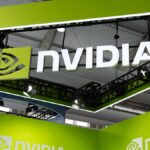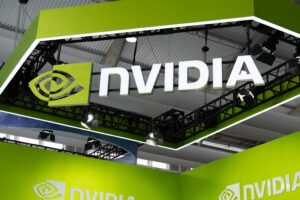<p class="canvas-atom canvas-text Mb(1.0em) Mb(0)–sm Mt(0.8em)–sm" type="text" content="Chipmakers have been caught in the crossfire of the ongoing trade war with China. In just the last five days, Micron Technology, Inc. (MU) and Nvidia Corporation (NVDA) share prices have fallen 6% and 4%, respectively. If further escalation occurs, investors fear that this decline will only intensify as each has significant business interests in China. However, some analysts have maintained a cautiously optimistic outlook on chip stocks, citing Advanced Micro Devices, Inc. (AMD) as an example of outperformance in spite of trade tensions. ” data-reactid=”11″>Chipmakers have been caught in the crossfire of the ongoing trade war with China. In just the last five days, Micron Technology, Inc. (MU) and Nvidia Corporation (NVDA) share prices have fallen 6% and 4%, respectively. If further escalation occurs, investors fear that this decline will only intensify as each has significant business interests in China. However, some analysts have maintained a cautiously optimistic outlook on chip stocks, citing Advanced Micro Devices, Inc. (AMD) as an example of outperformance in spite of trade tensions.
Do chip stocks still represent compelling investment opportunities despite widespread economic uncertainty? We take a closer look at these 3 chip stocks to try and answer that very question.
<h4 class="canvas-atom canvas-text Mb(1.0em) Mb(0)–sm Mt(0.8em)–sm" type="text" content="Micron Technology, Inc. (MU)” data-reactid=”13″>Micron Technology, Inc. (MU)
The first stock on our list has taken the biggest hit recently, with President Trump only adding fuel to the fire on August 9 after he stated, “We are not going to do business with Huawei… And I really made the decision. It’s much simpler not doing any business with Huawei…That doesn’t mean we won’t agree to something if and when we make a trade deal.” That being said, analysts believe that there’s more to the story.
Micron was able to perform well in the past when trade tensions heated up. Back in June, investors originally worried that the effects of the Huawei restrictions would weigh heavily on MU’s third quarter earnings. Huawei accounted for 13% of MU’s revenue in the first half of fiscal 2019.
However, on June 25, it reported that EPS was $1.05, ahead of the $0.79 consensus estimate. Revenue came in at $4.79 billion, surpassing the Street’s $4.69 billion estimate. While its quarterly revenue represented a 39% year-over-year decrease, it’s important to note that MU still managed to outperform in spite of the trade war.
Also working in MU’s favor, Japan recently placed restrictions on the export of chemical materials to South Korea. South Korean companies, which control 70% of the DRAM market and 50% of the NAND flash memory market, rely on these materials for chip production. This move could drive inventory levels lower which is good news for MU. As the demand for chips increases, analysts are hopeful that memory chip prices will rise as well.
<p class="canvas-atom canvas-text Mb(1.0em) Mb(0)–sm Mt(0.8em)–sm" type="text" content="Joseph Moore, a four-star analyst according to TipRanks, actually thinks the trade war will do some good for MU. He stated, “Global trade tensions and potential supply risks are driving shorter-term inventory accumulation, which makes our previous underweight rating less actionable.” On July 30, the Morgan Stanley analyst boosted his rating to a Hold and raised the price target from $31 to $48. While Moore isn’t as bullish as other analysts, he believes share prices could jump 16% over the next twelve months.” data-reactid=”18″>Joseph Moore, a four-star analyst according to TipRanks, actually thinks the trade war will do some good for MU. He stated, “Global trade tensions and potential supply risks are driving shorter-term inventory accumulation, which makes our previous underweight rating less actionable.” On July 30, the Morgan Stanley analyst boosted his rating to a Hold and raised the price target from $31 to $48. While Moore isn’t as bullish as other analysts, he believes share prices could jump 16% over the next twelve months.
<p class="canvas-atom canvas-text Mb(1.0em) Mb(0)–sm Mt(0.8em)–sm" type="text" content="Rajvindra Gill, a five-star analyst, argues that the Japan-Korea trade war puts MU in a position for growth. “We view these supply cuts as positive developments for Micron and the rest of the memory industry. We continue to be bullish on a stabilization in the supply-demand dynamic for NAND and DRAM in 2H19,” he said. On July 25, the Needham analyst reiterated his Buy rating and $50 price target, suggesting 20% upside potential.” data-reactid=”19″>Rajvindra Gill, a five-star analyst, argues that the Japan-Korea trade war puts MU in a position for growth. “We view these supply cuts as positive developments for Micron and the rest of the memory industry. We continue to be bullish on a stabilization in the supply-demand dynamic for NAND and DRAM in 2H19,” he said. On July 25, the Needham analyst reiterated his Buy rating and $50 price target, suggesting 20% upside potential.
MU has a ‘Moderate Buy’ analyst consensus and a $46 average price target, implying 10% upside.


Despite its recent dip, investors still have reason to be excited about Nvidia.
<p class="canvas-atom canvas-text Mb(1.0em) Mb(0)–sm Mt(0.8em)–sm" type="text" content="While China makes up 25% of the company’s revenue, top financial blogger, Louis Navellier, argues that investors shouldn’t give up on NVDA. “I’m not concerned about the near-term action, as I view Nvidia stock as a great long-term play. The reality is that the company has incredible long-term potential given that it is a leader in artificial intelligence — and it could lead to substantial gains down the road,” he wrote.” data-reactid=”35″>While China makes up 25% of the company’s revenue, top financial blogger, Louis Navellier, argues that investors shouldn’t give up on NVDA. “I’m not concerned about the near-term action, as I view Nvidia stock as a great long-term play. The reality is that the company has incredible long-term potential given that it is a leader in artificial intelligence — and it could lead to substantial gains down the road,” he wrote.
On July 10, the second round of results were released from the MLPerf Training v0.6, or the machine learning training performance benchmark suite that measures the performance of machine learning acceleration in hardware. Nvidia was the best-rated out of five chip-to-chip comparisons that included image recognition, translation and reinforcement learning or the methodology used to train robots on a factory floor.
According to the July 2019 Steam Hardware & Software Survey, the Nvidia GeForce GTX 1060 is the most popular video card for gaming. With Newzoo reporting that the gaming industry is expected to reach $174 billion by 2021, NVDA appears to be in a position to achieve long-term growth.


<p class="canvas-atom canvas-text Mb(1.0em) Mb(0)–sm Mt(0.8em)–sm" type="text" content="Vivek Arya, a five-star analyst, maintains his bullish stance even amid a tumultuous economic climate. On July 17, he reiterated his Buy rating and $225 price target. “While we continue to see some n-t macro headwinds (cloud inventory digestion, trade tensions), we remain bullish on NVDA long term due to its uniquely leverageable graphics platform and exposure to some of the fastest growth markets in semis – in particular the still budding $60bn TAM (total addressable market) for artificial intelligence (AI) chips/systems. Recently released MLPerf benchmark results are indicative of NVDA’s leadership and competitive moat,” he said. The Merrill Lynch analyst believes that share prices could soar by an impressive 46% over the next twelve months.” data-reactid=”46″>Vivek Arya, a five-star analyst, maintains his bullish stance even amid a tumultuous economic climate. On July 17, he reiterated his Buy rating and $225 price target. “While we continue to see some n-t macro headwinds (cloud inventory digestion, trade tensions), we remain bullish on NVDA long term due to its uniquely leverageable graphics platform and exposure to some of the fastest growth markets in semis – in particular the still budding $60bn TAM (total addressable market) for artificial intelligence (AI) chips/systems. Recently released MLPerf benchmark results are indicative of NVDA’s leadership and competitive moat,” he said. The Merrill Lynch analyst believes that share prices could soar by an impressive 46% over the next twelve months.
The rest of the Street is cautiously optimistic. NVDA has a ‘Moderate Buy’ analyst consensus and a $187 average price target, suggesting 22% upside potential.


<h4 class="canvas-atom canvas-text Mb(1.0em) Mb(0)–sm Mt(0.8em)–sm" type="text" content="Advanced Micro Devices, Inc. (AMD)” data-reactid=”56″>Advanced Micro Devices, Inc. (AMD)
AMD stands out from the other chip stocks on our list as it is the only one that saw share prices gain recently. AMD is up over 16% in the last five days, with analysts saying it’s poised to continue its upward trajectory.
<p class="canvas-atom canvas-text Mb(1.0em) Mb(0)–sm Mt(0.8em)–sm" type="text" content="The gains have largely been attributed to AMD’s second-generation EPYC 2 server chip, Rome. The company announced on August 7 that the chip is capable of double the level of performance of Intel Corporation’s (INTC) Xeon processor. Not to mention AMD’s chip is half the cost of Intel’s. ” data-reactid=”58″>The gains have largely been attributed to AMD’s second-generation EPYC 2 server chip, Rome. The company announced on August 7 that the chip is capable of double the level of performance of Intel Corporation’s (INTC) Xeon processor. Not to mention AMD’s chip is half the cost of Intel’s.
<p class="canvas-atom canvas-text Mb(1.0em) Mb(0)–sm Mt(0.8em)–sm" type="text" content="The positive sentiment surrounding AMD only increased after Google (GOOGL) and Twitter (TWTR) announced that they would be using the new EPYC chips as data center processors on August 8. TWTR believes that these chips will allow it to cut data center costs by up to 25%.” data-reactid=”59″>The positive sentiment surrounding AMD only increased after Google (GOOGL) and Twitter (TWTR) announced that they would be using the new EPYC chips as data center processors on August 8. TWTR believes that these chips will allow it to cut data center costs by up to 25%.
In a space that is dominated by Intel, which boasts 98% market share, AMD has made substantial progress in its efforts to expand its reach.
<p class="canvas-atom canvas-text Mb(1.0em) Mb(0)–sm Mt(0.8em)–sm" type="text" content="On August 7, Mitch Steves, a five-star analyst, assigned a Buy rating and set a $44 price target. The RBC Capital analyst believes share prices could soar by as much as 29% over the next twelve months. “We believe AMD’s competitive pricing and technical specifications will drive share gains at the expense of Intel Corp,” the RBC Capital analyst said. Steves boasts a 72% success rate and gets an average return of 20% per rating.” data-reactid=”61″>On August 7, Mitch Steves, a five-star analyst, assigned a Buy rating and set a $44 price target. The RBC Capital analyst believes share prices could soar by as much as 29% over the next twelve months. “We believe AMD’s competitive pricing and technical specifications will drive share gains at the expense of Intel Corp,” the RBC Capital analyst said. Steves boasts a 72% success rate and gets an average return of 20% per rating.
<p class="canvas-atom canvas-text Mb(1.0em) Mb(0)–sm Mt(0.8em)–sm" type="text" content="Matt Ramsay, another five-star analyst, thinks that while AMD still has work to do, he likes the improved technical specifications. “Overall, we anticipate Rome will begin a series of strong quarters of share gains starting in 3Q19 with strong 2H ramps at Amazon, Microsoft, and Google to be catalyzed by the newly introduced suite of 7-nanometer Rome products. As such we anticipate AMD should push toward 10% server share in early 2020 and exit 2020 with roughly 15% share,” he said. On August 6, the Cowen & Co. analyst reiterated his Buy rating and $40 price target, implying 17% upside potential.” data-reactid=”62″>Matt Ramsay, another five-star analyst, thinks that while AMD still has work to do, he likes the improved technical specifications. “Overall, we anticipate Rome will begin a series of strong quarters of share gains starting in 3Q19 with strong 2H ramps at Amazon, Microsoft, and Google to be catalyzed by the newly introduced suite of 7-nanometer Rome products. As such we anticipate AMD should push toward 10% server share in early 2020 and exit 2020 with roughly 15% share,” he said. On August 6, the Cowen & Co. analyst reiterated his Buy rating and $40 price target, implying 17% upside potential.
AMD has a ‘Moderate Buy’ analyst consensus and a $34 average price target, suggesting zero upside potential.


<p class="canvas-atom canvas-text Mb(1.0em) Mb(0)–sm Mt(0.8em)–sm" type="text" content="Discover the Analysts’ Top-Rated Stocks right now ” data-reactid=”72″>Discover the Analysts’ Top-Rated Stocks right now







